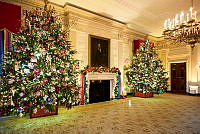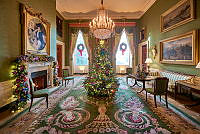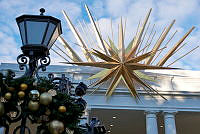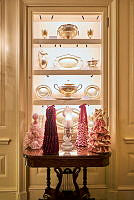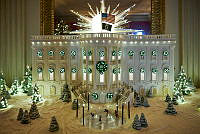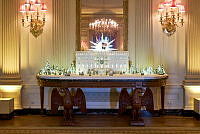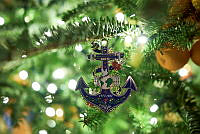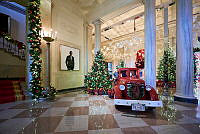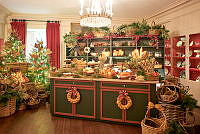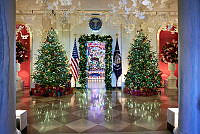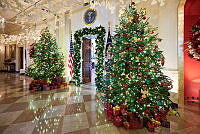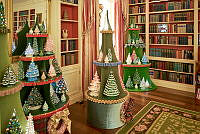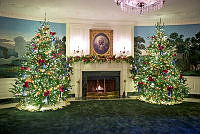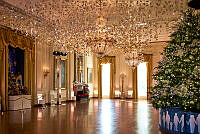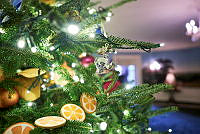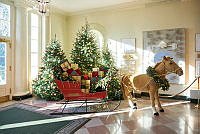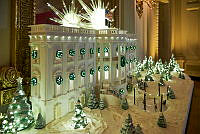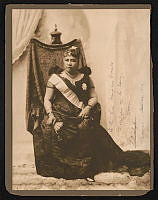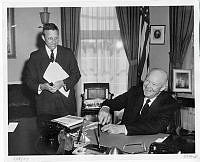Rubenstein Center Scholarship
The Life and Presidency of Grover Cleveland
The White House Christmas Ornament 2009 Historical Essay
Grover Cleveland's reelection in 1892, unprecedented for the four-year gap following an unsuccessful first bid for re-election, demonstrated his tenacity and the electorate's desire for a commanding leader. By presidential standards of the twentieth century, Cleveland was not a powerful chief executive. However, in the context of the 1880s, he boldly asserted powers that had been left dormant since the Civil War, battling with the Senate to recapture executive power and insisting on his right to appoint the principal officers of government. Americans wanted a return of executive authority; they believed in Cleveland's honesty, and hard work, and they shared a resentment of congressional favoritism toward big business and established wealth.
The spring of 1893, when Cleveland returned to the White House on a wave of revived popularity was a happy season. State receptions were crowded and more than 20,000 people attended the Easter Monday Egg Roll. On May 1, Cleveland opened the World Columbian Exposition in Chicago commemorating Columbus's discovery of the New World. Lighted by electricity, the spectacular "White City," made of plaster and wood, created a make-believe monumental neoclassical urban center and put on display America's celebration of consumption and technology. The fair symbolized Cleveland's hope of progress for the nation but outside forces soon shattered the dream. The Panic of 1893, precipitated by the failure of key corporations just ten days before Cleveland's March 4th inauguration, worsened as hundreds of banks closed and more than four million Americans were left jobless. When the stock market crashed on June 27, the nation entered the worst depression it had yet experienced.
The pressure put on the president by the financial crisis was exacerbated when he began suffering sharp pains in the roof of his mouth. Doctors discovered a tumor and ordered immediate surgery. Because of the turmoil caused by the Panic, Cleveland insisted that his surgery be kept secret. On the morning of June 30, the president issued an order for Congress to go into special session on August 7. He then traveled to New York with his family as though in route to Gray Gables, their summer cottage at Buzzard's Bay, Massachusetts. In New York, he boarded the steam yacht of his close friend and business associate, the millionaire Commodore Elias C. Benedict. The following day a dentist and five doctors performed an operation at sea, removing the president's malignant tumor as well as his entire upper left jaw and part of his palate. An artificial rubber device was fitted to fill the cavity left by the surgery. Five days later attendants hurried the president ashore at Buzzard's Bay where he made a rapid recovery. The reporters who flocked to Gray Gables learned of the surgery but honored his secret. Remarkably, the episode was not revealed to the public until 1917, when the principal doctor wrote a full detailed account for posterity in the Saturday Evening Post.
Hard times continued for four more years. The economic crisis combined with Cleveland's health problems, left him 60 pounds thinner, hearing-impaired, and even more irritable and stubborn than his famous reputation. When the unemployed workers of Coxey's Army, marched in protest on Washington, D.C., Cleveland ordered the National Guard to disperse them. When the workers of the Pullman Car Company struck in the summer of 1894, bringing open violence to the city of Chicago, Cleveland sent in federal troops with police powers, thus becoming the first president to claim the right to intervene forcibly in a labor dispute for the sake of the national economy. His actions in Washington and Chicago lost him the support of labor leaders and American workers. The subsequent resounding defeat of the Democratic Party in the midterm elections of 1894 greatly weakened his congressional support and the domestic ambitions of his second presidential term were ultimately unsuccessful. His foreign affairs policy is nevertheless remembered by his defiance of British claims to gold fields in a border dispute with Venezuela. And he was the first president to receive at the White House a full rank ambassador to the United States. However negative public opinion may have been when he left office in 1897, Grover Cleveland had sown the seed of the powerful modern presidency.
"A CHILDREN'S FESTIVAL" THE CLEVELAND FAMILY OBSERVES CHRISTMAS, 1893–1896
Grover Cleveland's presidency was personally gratifying for him due to the support and love of his family. He returned to the White House for his second term in 1893 with his beautiful young wife Frances and one-year old daughter Ruth. On September 9, 1893, the Cleveland's welcomed the arrival of a second daughter, Esther, the first child of a president to be born in the White House. Their third daughter, Marion, was born in 1895 at Buzzard's Bay. The three children brought life and joy to the White House. In the president's retirement two sons would complete the family: Richard in 1897, and Francis, born in 1903.
Christmas at the Cleveland White House naturally focused on the president's daughters. A typical Christmas menu included oysters, bouillon, roast turkey with cracker stuffing, roast pork, boiled onions, jellied cranberries, mashed turnips, chicken patties, green salad, olives, fancy pastries, ices, plenty of fruits and nuts, pies of all kinds, and coffee. In 1896, a newspaper noted that the family's turkey weighed 57 pounds. Ample food from the same menu was also available to the domestic staff who ate their meals downstairs.
Mrs. Cleveland made the Christmas tree, stylishly laden with toys, the center of White House holiday decorations. President Cleveland preferred the old-fashioned tradition of hanging stockings on the fireplace mantel and insisted on stuffing them with bon bons in the toes, figs in the heels, and toys to fill the legs. The Cleveland's hosted an annual Christmas Eve children's party for their tots and for the children of Cabinet members. That evening they also gave turkeys to the married staff members and gifts to the rest.
To the delight of Ruth, Esther, and Marion, Mrs. Cleveland placed through the Christmases ever more elaborate trees in the library. An 1896 newspaper account described the family's tree as "a tremendous pine, fully twenty feet tall" laden with presents and decorated with "tinsel and twinkling with red, white and blue electric lights." As for the president, he enjoyed nothing more than a Christmas duck hunt. In 1894, the Washington Evening Star reported that Cleveland gave each of his cabinet members a duck for Christmas dinner, the spoils of his hunting vacation in South Carolina, which left him with a "bronzed face, bright eyes and a more elastic step." But he reserved Christmas day only for the pleasure of his daughters. Christmas morning the girls opened their gifts and the president and first lady joined the excited children making merry with their new toys. Christmas at the Cleveland White House, as an Illinois reporter described it in 1896, was a "children's festival."
FURTHER READING:
Graff, Henry F. Grover Cleveland, New York, Times Books, 2002.
Seale, William. The President's House: A History, 2008.
Seale, William. The White House: The History of an American Idea, 2002.
HISTORIC SITES:
Grover Cleveland Birthplace State Historic Site, 207 Bloomfield Avenue, Caldwell, NJ
President Cleveland's burial site is in the Princeton Cemetery, Princeton, NJ.














